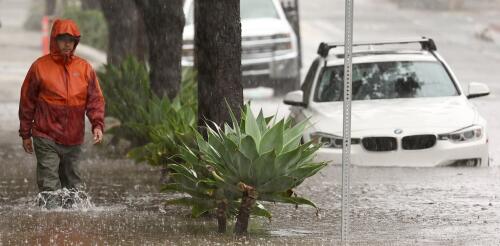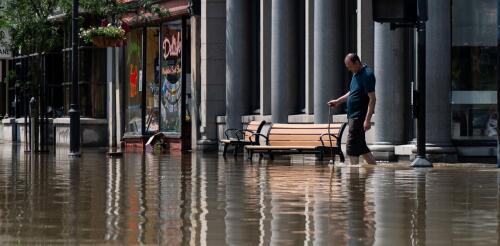Heat wave
The heat wave that left more than 100 million people sweating across the eastern U.S. in June 2024 hit so fast and was so extreme that forecasters warned a flash drought could follow across wide parts of the region. Prolonged high temperatures can quickly dry soils, triggering a rapid onset drought that can affect agriculture, water resources and energy supplies. Many regions under the June heat dome quickly developed abnormally dry conditions. The National Oceanic and Atmospheric Administration’s hazard outlook map shows flash drought warnings in yellow and areas forecast to have a high risk of excessive heat in early July in red. NOAA Climate Prediction Center The human impacts of the heat wave have also been widespread. In Ohio and Pennsylvania, emergency room visits for heat-related illnesses surged. Several Massachusetts schools without air conditioning closed to protect kids and teachers...
A deadly heat wave gripped Asia for weeks in spring 2024, sending temperatures in India’s capital region over 120 degrees Fahrenheit (49 Celsius) in May. Campaigning politicians, news announcers and Indian voters waiting in long lines passed out in the oppressive heat. In June, hundreds of people on the Hajj, a Muslim pilgrimage to Mecca, Saudi Arabia, died in searing heat that reached 120 F (49 C) with high humidity. Most of the planet has suffered the dire effects of extreme heat in recent years. Phoenix hit 110 F (43.3 C) or higher for 31 straight days in summer 2023, and Europe saw unprecedented heat that killed hundreds and contributed to devastating wildfires in Greece. Mexico and neighboring regions were sweltering through a dangerous and long-running heat wave in 2024. Regardless of where or when a heat wave strikes, one pattern has been a constant: Older adults are the most likely to die from extreme heat, and the crisis is worsening....
Many Americans think of power outages as infrequent inconveniences, but that’s quickly changing. Nationwide, major power outages have increased tenfold since 1980, largely because of an aging electrical grid and damage sustained from severe storms as the planet warms. At the same time, electricity demand is rising as the population grows and an increasing number of people use electricity to cool and heat their homes, cook their meals and power their cars. A growing number of Americans also rely on electricity-powered medical equipment, such as oxygen concentrators to help with breathing, lifts for movement and infusion pumps to deliver medications and fluids to their bodies. For older adults and others with health conditions, a loss of power may be more than an inconvenience. It can be life-threatening. We study environmental health, including the effects of extreme heat and storms on people. In a new study, we analyzed data from New York City and the surrounding area to...
Wild weather has been roiling North America for the past few months, thanks in part to a strong El Niño that sent temperatures surging in 2023. The climate phenomenon fed atmospheric rivers drenching the West Coast and contributed to summer’s extreme heat in the South and Midwest and fall’s wet storms across the East. That strong El Niño is now starting to weaken and will likely be gone by late spring 2024. So, what does that mean for the months ahead – and for the 2024 hurricane season? What is El Niño? Let’s start with a quick look at what an El Niño is. El Niño and its opposite, La Niña, are climate patterns that influence weather around the world. El Niño tends to raise global temperatures, as we saw in 2023, while La Niña events tend to be slightly cooler. The two result in global temperatures fluctuating above and below the warming trend set by climate change. El Niño starts as warm water builds up a...
National weather analysts released their 2023 billion-dollar disasters list on Jan. 9, just as 2024 was getting off to a ferocious start. A blizzard was sweeping across across the Plains and Midwest, and the South and East faced flood risks from extreme downpours. The U.S. set an unwelcome record for weather and climate disasters in 2023, with 28 disasters that exceeded more than US$1 billion in damage each. While it wasn’t the most expensive year overall – the costliest years included multiple hurricane strikes – it had the highest number of billion-dollar storms, floods, droughts and fires of any year since counting began in 1980, with six more than any other year, accounting for inflation. 2023’s billion-dollar disasters. Click the image to expand. NOAA The year’s most expensive disaster started with an unprecedented heat wave that sat over Texas for weeks over...




